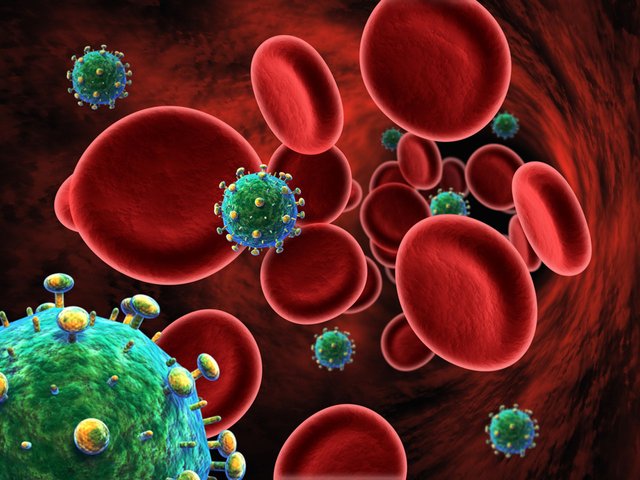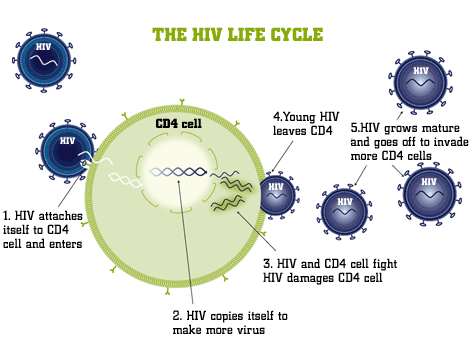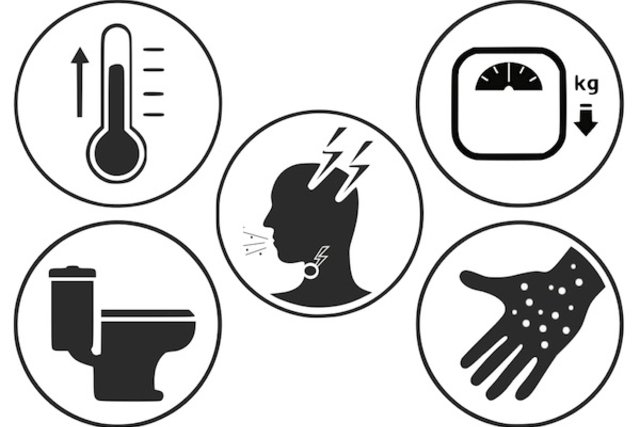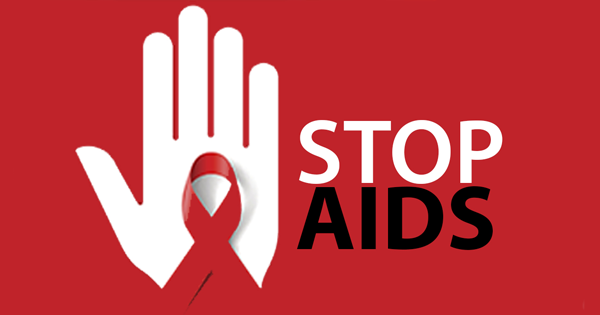Study of the infection by the human immunodeficiency virus (VIH)
Hi steemians! The human immunodeficiency virus (HIV) is the virus that causes AIDS. When a person becomes infected with HIV, the virus attacks and weakens the immune system. As the immune system weakens, the person runs the risk of getting infections and cancers that can be deadly. When this happens, the disease is called AIDS. Once a person has the virus, he remains in the body for life.

What is AIDS (HIV)
HIV or the human immunodeficiency virus is a retrovirus that attacks the immune system of the infected person. The immune system is the natural defense of our body against infectious microorganisms, such as bacteria, viruses and fungi capable of invading our body.
In particular, HIV attacks and destroys CD4 lymphocytes, which are a type of cells that are part of the immune system and are responsible for making antibodies to fight infections caused by these external agents.

What can happen to your body if it is infected
Viruses are not capable of reproducing themselves, they need to use other living beings to multiply and survive. When you get infected, HIV goes to your target cells, CD4. When it finds a CD4, the virus attaches itself to the membrane of the cell and fuses its capsid with the cell membrane, so that now it can introduce its genetic material so that this cell can reproduce it (multiply it). Once replication has begun, it spreads to the blood and spreads throughout the body infecting other cells that will also use them to multiply their genetic material.
When this multiplication takes place, there are copies of the virus circulating in the blood (the number of copies of the virus is what is known as Viral Load) and the number of CD4 cells in the body is reduced, which ends up producing an immunity deficiency. At this time, the body loses defensive capacity, making the person suffering from it more likely to contract other infections or develop HIV-related diseases, known as opportunistic diseases. They are caused by agents that, when faced with immune systems that function normally, do not cause any disease. Only when the immune system weakens severely, do they take advantage of the "opportunity" to develop infections.

Causes of AIDS / HIV
The virus is transmitted from one person to another in any of the following ways:

- Through sexual contact
- Through the blood by blood transfusions (now very rare in the United States) or, more often, by sharing needles
- From mother to child a pregnant woman can transmit the virus to her fetus through shared blood circulation, or a nursing mother can pass it to her baby through breast milk
People at increased risk of HIV include

- Drug addicts who inject drugs and then share needles
- Babies born to mothers with HIV who did not receive treatment against the virus during pregnancy
- People involved in unprotected sex, especially with individuals who have other high-risk behaviors, who are HIV positive or who have AIDS
- Sex partners of people who participate in high-risk activities (such as injecting drug use or anal sex)After HIV infects the body, the virus can be found in many different fluids and tissues in the body.
- It has been shown that only semen, blood, vaginal fluid and breast milk transmit the infection to others.
- The virus can also be found in saliva, tears and cerebrospinal fluid.
symptom
At the end of a few weeks of HIV infection, symptoms such as fever, sore throat and fatigue may appear. Then, the disease is usually asymptomatic until it becomes AIDS. Symptoms include weight loss, fever or night sweats, recurrent infections and fatigue.
There is no cure for AIDS, but strict observation of antiretroviral therapy can significantly decrease the progress of the disease and prevent infections and secondary complications.

The VHI is not transmitted by
- Casual contact, like a hug
- Mosquitoes
- Participation in sports
- Touching things that have been touched before by a person infected with the virus
Preventive measures against HIV

- Get tested and know the status of your partner related to HIV. Talk to your partner about HIV testing and get tested before having sex. To find a nearby site for HIV testing, use this locator from the Centers for Disease Control and Prevention (CDC).
- Have sex less risky. HIV is transmitted mainly by having anal or vaginal sex without a condom or taking medication to prevent or treat the infection.
- Use of condoms. Use a condom correctly every time you have vaginal, anal or oral sex. Read the following fact sheet from the Centers for Disease Control and Prevention (CDC) on how to use condoms correctly.
- Limit your number of sexual partners. The more couples you have, the more likely you are that one of them has HIV and is not well controlled or has a partner with a sexually transmitted disease (STD). These two factors can increase your risk of HIV transmission. If you have more than one sexual partner, get tested for HIV regularly.
- Get tested and receive treatment for sexually transmitted diseases. Insist that your partners get tested and treated as well. Having an STD can increase your risk of HIV infection or spread to others.
- Talk to your health care provider about pre-exposure prophylaxis (PrEP). Pre-exposure prophylaxis (PrEP) is an option to prevent HIV in people who do not have the virus but are at high risk of contracting it. PrEP involves taking a specific anti-HIV medication every day. PrEP should always be combined with other prevention options, such as the use of condoms. For additional information, read the information sheet on pre-exposure prophylaxis (PrEP) of AIDSinfo.
- Do not inject drugs, but if you do, use only sterile injection equipment and needles and never share your equipment with other people.
Treatment
Currently there are drugs, called antiretroviral drugs, that inhibit essential enzymes, reverse transcriptase, retrotranscriptase or protease, which reduces the replication of HIV. In this way, the progress of the disease and the appearance of opportunistic infections slow down, so that although AIDS can not be adequately cured, it can be converted with the continued use of these drugs into a chronic disease compatible with a long and almost normal The enzyme of HIV, retrotranscriptasa, is an enzyme that converts RNA into DNA, so it has become one of the main targets of antiretroviral treatments.
In 2007, the European Medicines Agency (EMEA) authorizes the drug Atripla that combines three of the most common antiretrovirals in a single pill. The active substances are efavirenz, emtricitabine and disoproxil of tenofovir. The drug is indicated for the treatment of virus-1 in adults.
The common denominator of the treatments currently applied is the combination of different antiretroviral drugs, commonly called "cocktails". These "cocktails" replaced the traditional single-drug therapies that are only maintained in the case of HIV-positive pregnant women. Different drugs tend to prevent the multiplication of the virus and slow down the process of deterioration of the immune system. The "cocktail" consists of two drugs reverse transcriptase inhibitors (drugs) AZT, DDI, DDC, 3TC and D4T) and an inhibitor of other protease enzymes.
In 2010, the elimination of the virus from a patient with leukemia was verified by receiving a bone marrow transplant from a donor with a very rare genetic mutation that makes him immune to HIV infection; He recovered from both diseases. Being a very rare mutation and an operation with high risks, the possibility that this becomes a practical solution is almost non-existent at this time. Despite the results, operations of this type require doses of immunosuppressants for life. The genetic defect in question causes the T cells not to express the CCR5 or CXCR4 receptor that the virus needs to recognize to enter the cell.
In people with enteropathy due to HIV, it has been documented that the gluten-free diet produces an improvement in diarrhea and allows weight recovery. In fact, the intestinal lesions found in these cases are similar to those caused by celiac disease.
Thank you for your attention!
Good read, you covered everything from what it is to how it is managed and how to prevent. HIV very deadly especially where I am now in the US, and it effects people with poverty even more. The medication is expensive and a lot of people succumb to the effects of AIDS. I think the best way to approach would be educate people and take more preventative measures. It’s also more cost effective that way lol
Exact friend, the best way to avoid HIV is to implement rules that help prevent this deadly disease, thank you for commenting, regards